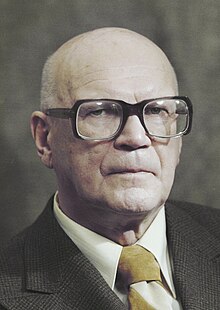
Back أورهو ككونن Arabic اورهو ككونن ARZ Urho Kekkonen AST Urho Kekkonen Azerbaijani Урха Кеканен Byelorussian Урха Кеканэн BE-X-OLD উরহো কেকোনন Bengali/Bangla Urho Kekkonen Breton Urho Kekkonen BS Urho Kekkonen Catalan
Urho Kekkonen | |
|---|---|
 Kekkonen in 1975 | |
| 8th President of Finland | |
| In office 1 March 1956 – 27 January 1982 | |
| Prime Minister | |
| Preceded by | Juho Kusti Paasikivi |
| Succeeded by | Mauno Koivisto |
| Prime Minister of Finland | |
| In office 20 October 1954 – 3 March 1956 | |
| President | Juho Kusti Paasikivi |
| Preceded by | Ralf Törngren |
| Succeeded by | Karl-August Fagerholm |
| In office 17 March 1950 – 17 November 1953 | |
| President | Juho Kusti Paasikivi |
| Preceded by | Karl-August Fagerholm |
| Succeeded by | Sakari Tuomioja |
| Personal details | |
| Born | 3 September 1900 Pielavesi, Grand Duchy of Finland, Russian Empire |
| Died | 31 August 1986 (aged 85) Helsinki, Finland |
| Resting place | Hietaniemi Cemetery |
| Political party | Agrarian League (1933–1965) Centre Party (1965–1982) |
| Spouse | |
| Children | Matti, Taneli |
| Residence | Tamminiemi |
| Alma mater | University of Helsinki |
| Occupation |
|
| Signature | |
| Nickname(s) | UKK, Urkki |
Urho Kaleva Kekkonen[a] (3 September 1900 – 31 August 1986), often referred to by his initials UKK, was a Finnish politician who served as the eighth and longest-serving president of Finland from 1956 to 1982. He also served as prime minister (1950–1953, 1954–1956), and held various other cabinet positions.[1] He was the third and most recent president from the Agrarian League/Centre Party. Head of state for nearly 26 years, he dominated Finnish politics for 31 years overall. Holding a large amount of power, he won his later elections with little opposition and has often been classified as an autocrat.[2]
As president, Kekkonen continued the "active neutrality" policy of his predecessor President Juho Kusti Paasikivi that came to be known as the Paasikivi–Kekkonen doctrine, under which ostensibly Finland was to retain its independence while maintaining good relations and extensive trade with members of both NATO and the Warsaw Pact. Critical commentators referred to this policy of appeasement pejoratively as Finlandization. He hosted the Conference on Security and Co-operation in Europe in Helsinki in 1975 and was considered a potential candidate for the Nobel Peace Prize that year. He is credited by Finnish historians for his foreign and trade policies, which allowed Finland's market economy to keep pace with Western Europe even with the Soviet Union as a neighbor, and for Finland to gradually take part in the European integration process.[3] On the other hand, his perceived hunger for power, his divide-and-rule attitude in domestic politics and the lack of genuine political opposition, especially during the latter part of his presidency, significantly weakened Finnish democracy during his presidency.[3] After Kekkonen's presidency, the reform of the Constitution of Finland was initiated by his successors to increase the power of the Parliament and the prime minister at the expense of the president.
Kekkonen was a member of the Parliament of Finland from 1936 until his rise to the presidency. Either prior, during or between his premierships, he served as minister of justice (1936–37, 1944–46, 1951), minister of the interior (1937–39, 1950–51), speaker of the Finnish Parliament (1948–50) and minister of foreign affairs (1952–53, 1954). In addition to his extensive political career, he was a lawyer by education, a policeman and athlete in his youth, a veteran of the Finnish Civil War, and an enthusiastic writer. During World War II, his anonymous reports on the war and foreign politics received a large audience in the Suomen Kuvalehti magazine.[3] Even during his presidency, he wrote humorous, informal columns (causerie) for the same magazine, edited by his long-time friend Ilmari Turja,[4] under several pseudonyms.
Cite error: There are <ref group=lower-alpha> tags or {{efn}} templates on this page, but the references will not show without a {{reflist|group=lower-alpha}} template or {{notelist}} template (see the help page).
- ^ "Ministerikortisto". Valtioneuvosto. Archived from the original on 6 April 2009. Retrieved 21 December 2008.
- ^ Kekkonen, Urho. Kansallisbiografia (English edition). (The section "The rise to the position of 'autocrat'")
- ^ a b c Kekkonen, Urho. Kansallisbiografia (English edition).
- ^ "Ilmari Turja" (in Finnish). Helsingin Sanomat. 6 January 1998. Retrieved 27 February 2021.